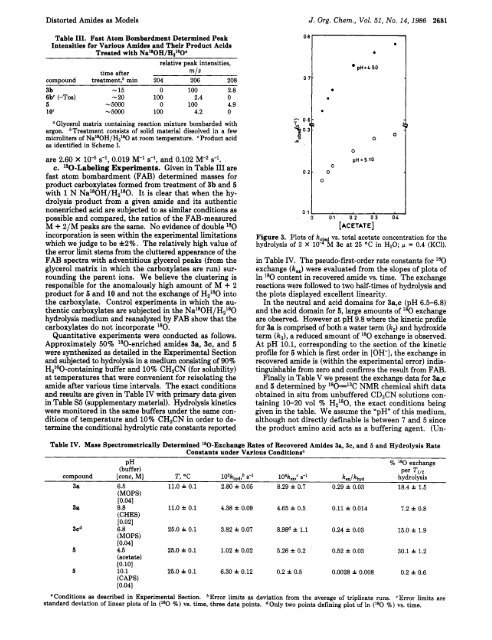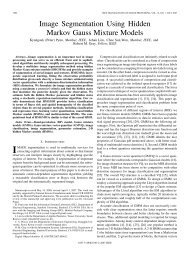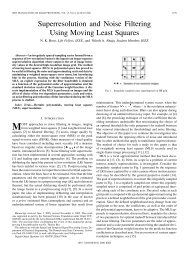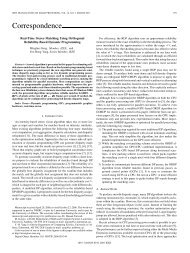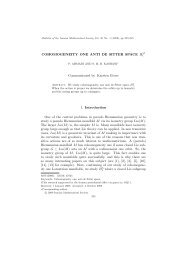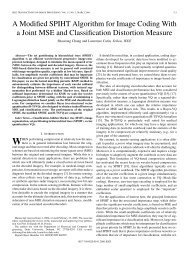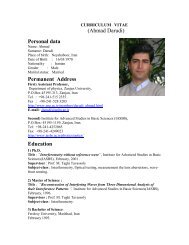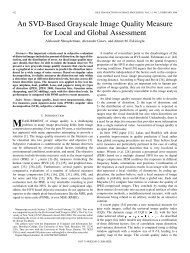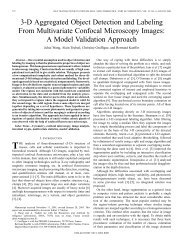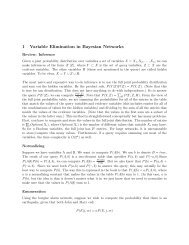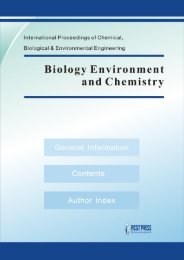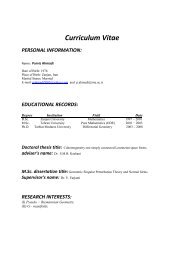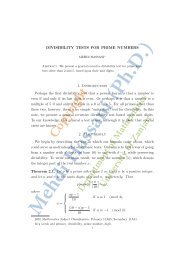Org. Chem. 1986,51, 2676
Org. Chem. 1986,51, 2676
Org. Chem. 1986,51, 2676
You also want an ePaper? Increase the reach of your titles
YUMPU automatically turns print PDFs into web optimized ePapers that Google loves.
Distorted Amides as Models J. <strong>Org</strong>. <strong>Chem</strong>., Vol. <strong>51</strong>, No. 14, <strong>1986</strong> 2681<br />
Table 111. Fast Atom Bombardment Determined Peak<br />
Intensities for Various Amides and Their Product Acids<br />
Treated with Na1*OH/H2'*O"<br />
relative peak intensities,<br />
time after mlz<br />
comDound treatment? min 204 206 208<br />
3b - 15 0 100 2.8<br />
6b' (-Tos) - 20 100 2.4 0<br />
5 - 5000 0 100 4.9<br />
1 O C - 5000 100 4.2 0<br />
Glycerol matrix containing reaction mixture bombarded with<br />
argon. *Treatment consists of solid material dissolved in a few<br />
microliters of Na1*OH/HJ80 at room temperature. Product acid<br />
as identified in Scheme I.<br />
are 2.60 X 8 , 0.019 M-ls-l, and 0.102 M-2 s-l.<br />
c. l8O-Labeling Experiments. Given in Table I11 are<br />
fast atom bombardment (FAB) determined masses for<br />
product carboxylates formed from treatment of 3b and 5<br />
with 1 N Na180H/H,'80. It is clear that when the hydrolysis<br />
product from a given amide and its authentic<br />
nonenriched acid are subjected to as similar conditions as<br />
possible and compared, the ratios of the FAB-measured<br />
M + 2/M peaks are the same. No evidence of double l80<br />
incorporation is seen within the experimental limitations<br />
which we judge to be f2%. The relatively high value of<br />
the error limit stems from the cluttered appearance of the<br />
FAB spectra with adventitious glycerol peaks (from the<br />
glycerol matrix in which the carboxylates are run) surrounding<br />
the parent ions. We believe the clustering is<br />
responsible for the anomalously high amount of M + 2<br />
product for 5 and 10 and not the exchange of H2180 into<br />
the carboxylate. Control experiments in which the authentic<br />
carboxylates are subjected in the Na180H/H21s0<br />
hydrolysis medium and reanalyzed by FAB show that the<br />
carboxylates do not incorporate l80.<br />
Quantitative experiments were conducted as follows.<br />
Approximately 50% 180-enriched amides 3a, 3c, and 5<br />
were synthesized as detailed in the Experimental Section<br />
and subjected to hydrolysis in a medium consisting of 90%<br />
H,'60-containing buffer and 10% CH3CN (for solubility)<br />
at temperatures that were convenient for reisolating the<br />
amide after various time intervals. The exact conditions<br />
and results are given in Table IV with primary data given<br />
in Table S5 (supplementary material). Hydrolysis kinetics<br />
were monitored in the same buffers under the same conditions<br />
of temperature and 10% CH3CN in order to determine<br />
the conditional hydrolytic rate constants reported<br />
08<br />
"'I<br />
0.6<br />
# I 3 3 0.3<br />
Po<br />
x<br />
02<br />
0<br />
0<br />
0<br />
0<br />
0<br />
0<br />
a<br />
pH:L,50<br />
0<br />
pH = 5,lO<br />
01-<br />
0 01 02 03 01<br />
[ACETATE]<br />
Figure 3. Plots of k, d vs. total acetate concentration for the<br />
hydrolysis of 3 X 10- B" M 3c at 25 "C in HzO; p = 0.4 (KC1).<br />
in Table IV. The pseudo-first-order rate constants for l 80<br />
exchange (kex) were evaluated from the slopes of plots of<br />
In l80 content in recovered amide vs. time. The exchange<br />
reactions were followed to two half-times of hydrolysis and<br />
the plots displayed excellent linearity.<br />
In the neutral and acid domains for 3a,c (pH 6.5-6.8)<br />
and the acid domain for 5, large amounts of l80 exchange<br />
are observed. However at pH 9.8 where the kinetic profile<br />
for 3a is comprised of both a water term (k,) and hydroxide<br />
term (k3), a reduced amount of lSO exchange is observed.<br />
At pH 10.1, corresponding to the section of the kinetic<br />
profile for 5 which is first order in [OH-], the exchange in<br />
recovered amide is (within the experimental error) indis-<br />
tinguishable from zero and confirms the result from FAB.<br />
Finally in Table V we present the exchange data for 3a,c<br />
and 5 determined by 180=13C NMR chemical shift data<br />
obtained in situ from unbuffered CD,CN solutions con-<br />
taining 10-20 vol 70 H2180, the exact conditions being<br />
given in the table. We assume the "pH" of this medium,<br />
although not directly definable is between 7 and 5 since<br />
the product amino acid acts as a buffering agent. (Un-<br />
Table IV. Mass Spectrometrically Determined 180-Exchange Rates of Recovered Amides 3a, 3c, and 5 and Hydrolysis Rate<br />
Constants under Various Conditionsa<br />
~<br />
PH % l80 exchange<br />
compound<br />
(buffer)<br />
[conc, M] T, "C 103khyd,* 8-1 104k,,,e ~1 ksx/khyd<br />
Per TI/!<br />
hydrolysis<br />
3a 6.5<br />
(MOPS)<br />
[0.04]<br />
11.0 f 0.1 2.80 f 0.05 8.29 f 0.7 0.29 f 0.03 18.4 f 1.5<br />
3a 9.8<br />
(CHES)<br />
[0.02]<br />
11.0 f 0.1 4.38 f 0.09 4.65 f 0.5 0.11 f 0.014 7.2 f 0.8<br />
3Cd 6.8<br />
(MOPS)<br />
[0.04]<br />
25.0 f 0.1 3.82 f 0.07 8.98d f 1.1 0.24 f 0.03 15.0 f 1.9<br />
5 4.5<br />
(acetate)<br />
[0.10]<br />
25.0 f 0.1 1.02 f 0.02 5.26 i 0.2 0.52 f 0.03 30.1 f 1.2<br />
5 10.1<br />
(CAPS)<br />
[0.04]<br />
25.0 f 0.1 6.30 f 0.12 0.2 f 0.5 0.0028 i 0.008 0.2 f 0.6<br />
"Conditions as described in Experimental Section. *Error limits as deviation from the average of triplicate runs. 'Error limits are<br />
standard deviation of linear plots of In ('*O 9%) vs. time, three data points. dOnly two points defining plot of In (l80 %) vs. time.<br />
a


